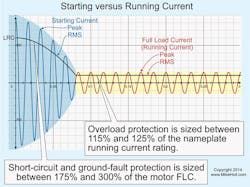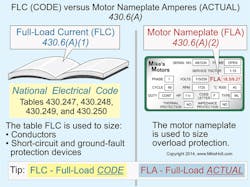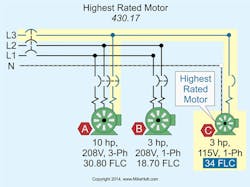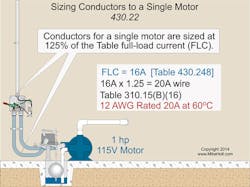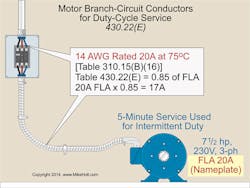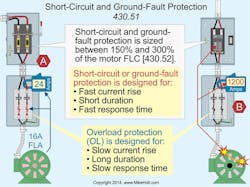When motors start across the line, they typically draw five times the running current. This temporary “inrush” is an overload condition. To handle inrush while still providing adequate overcurrent protection, we divide overcurrent protection into two parts (Fig. 1):
1. Short circuit and ground fault protection. Typically, this is via a fuse or circuit breaker sized large enough to let the motor start. But if it’s large enough to let the motor start, it’s too large to provide overload protection.
2. Overload protection. This protects the motor and wiring at a value close to the actual running current of the motor, but with sufficient time delay to allow the motor to start.
Which current?
When performing motor calculations, should you use the motor full load current (FLC) (Code) or the full load amperes (FLA) (actual)? The wrong answer can result in overcurrent protection that inhibits operation or simply fails to protect (Fig. 2).
• The FLC is in NEC Tables 430.247, 430.248, and 430.250 [Sec. 430.6(A)(1)].
• The FLA is the motor nameplate rating [Sec. 430.6(A)(2)]. This is the current the motor draws while producing its rated horsepower at its rated voltage (based on its rated efficiency and power factor).
The actual current drawn by the motor depends on the load on the motor and on the actual operating voltage at the motor terminals. If the load increases, the current increases. If the motor operates at a voltage below its nameplate rating, then the operating current increases.
Use the FLC to determine the:
• Conductor ampacity [Sec. 430.22].
• Circuit short circuit and ground fault overcurrent device size [Sec. 430.52 and Sec. 430.62].
• Ampere rating of disconnecting switches [Sec. 430.110].
Use the FLA to determine the:
• Conductor ampacity as covered in Sec. 430.22(E) for other than continuous duty.
• Branch circuit short circuit and ground fault overcurrent device size.
You must use the FLA for:
• Motors built to operate at less than 1,200 RPM.
• High torque motors with higher FLCs.
• Multispeed motors (full-load current varies with speed).
And if you have a listed motor-operated appliance, you must use the motor FLC marked on the appliance nameplate (instead of the horsepower rating on the appliance nameplate) to determine the ampacity or rating of the disconnecting means, the branch circuit conductors, the controller, and the branch circuit short circuit and ground fault protection.
Highest rated
When selecting the feeder conductors or the feeder short circuit ground fault protection device, the highest rated motor is the one with the highest FLC (not the highest horsepower) [Sec. 430.17]. Let’s run through an example problem to bring this point home.
Which of the following three is the highest rated motor (Fig. 3)?
a) 10 hp, 208V, 3-phase
b) 3 hp, 208V, single-phase
c) 3 hp, 120V, single-phase
As per Table 430.250, a 10 hp, 208V, 3-phase motor has a FLC of 30.8A.
As per Table 430.248, a 3 hp, 208V, single-phase motor has a FLC of 18.7A.
As per Table 430.248, a 3 hp, 120V, single-phase motor has a FLC of 34A. Therefore, the correct answer is: c).
Sizing branch circuit conductors
When working with motors that are Design B, C, or D, you can size the conductors to the 75°C ampacity column of Table 310.15(B)(16) [110.14(C)(1)(a)(4)]. The ampacity of branch circuit conductors to a single motor used for continuous duty must be at least 125% of the motor FLC listed in Tables 430.247 through 430.250 [Sec. 430.6(A)(1) and Sec. 430.22].
When selecting motor current from one of these tables, note the last sentence above each table; you can use the ampacity columns for several common system voltages without any adjustment. But you must select the actual conductor size from Table 310.15(B)(16) per the terminal temperature rating (60°C or 75°C) of the equipment [Sec. 110.14(C)(1)].
Motor applications are continuous duty unless the nature of the control (or apparatus that the motor drives) is designed such that the motor won’t operate continuously with load [Table 430.22(E), Note]. When a motor isn’t continuous duty because of this type of application, size the conductors using the percentages of Table 430.22(E). And if a motor must stop during the course of performing its function (e.g., elevator motor), that’s a good sign it’s intermittent duty.
Let’s run through another example problem now.
What size conductors are required for a 1 hp, single-phase, 115V motor, where the terminals are rated 60°C (Fig. 4)? First, find the motor FLC in Table 430.248. A quick check reveals this to be 16A. Then, size the conductor no less than 125% of the motor FLC: 16A × 1.25 = 20A.
A quick check of Table 310.15(B)(16) reveals the answer to be a 12 AWG conductor.
Here’s another example problem for a duty-cycle service.
What size branch circuit conductors are required for a 7½ hp, 3-phase, 230V motor with a nameplate FLA of 20A, rated for 5-min. service, used for intermittent duty, where the terminals are rated 75°C (Fig. 5)?
Use the motor nameplate FLA for duty-cycle service.
The conductor size must be at least 85% of the motor FLA [Table 430.22(E)]:
20A × 0.85 = 17A
A quick check of Table 310.15(B)(16) reveals the answer to be a 14 AWG conductor.
The minimum size conductor permitted for building wiring is 14 AWG [Table 310.106(A)]; however, some local codes and many industrial facilities require 12 AWG as the smallest branch circuit conductor.
Instead of using the FLC Tables, use the FLA from the motor nameplate with Table 430.22(E) [Sec. 430.6(A)(1)].
Overcurrent
When current exceeds the rated current of the equipment or conductors, you have overcurrent. Short circuits, ground faults, and overloads are conditions that produce it (Fig. 6).
• Short circuits and ground faults involve relatively large current changes and happen quickly. Because they are very low impedance, they typically carry several times the desired current (e.g., 200A on a 20A circuit).
• Overloads involve relatively small current changes and (usually) happen slowly. Think of overloads as too many straws on the camel’s back. An example is 22A on a 20A circuit.
Because of the nature of these conditions:
• Short circuit or ground fault protection is designed for fast current rise, short duration, and fast response time.
• Overload protection is designed for slow current rise, long duration, and slow response time.
Branch circuit short circuit and ground fault protection devices (e.g., circuit breakers) protect the motor, the motor control apparatus, and the conductors against short circuits or ground faults. But they don’t protect against an overload [Sec. 430.51]; for that, you need overload protection devices (OPDs).
The QT on OPD
Some causes of overload are:
• Power problems (e.g., low voltage, low power factor, voltage imbalance).
• Motor damage (winding problems, bearing failure) or locked rotor.
• Motor too small for the application.
• Single-phasing (one conductor of a three-phase circuit fails, leaving only two phases to run motor).
• Problems in the connected load ( e.g., gearbox low on lubricant).
Issues like these are why motor circuits need overload protection, not just a breaker big enough to let them start.
OPDs protect the motor, the motor control equipment, and the motor branch circuit conductors from excessive heating due to motor overload [Sec. 430.31]. They provide this protection at a value close to the motor running current, but with sufficient delay to allow the motor to start. That is, the delay is enough that the OPDs stay closed during the normal window of high starting current.
OPDs come in many forms. If your OPDs are fuses, you must install a fuse for each ungrounded conductor [Sec. 430.36 and Sec. 430.55].
Commonly, OPDs are “heaters” in a magnetic starter. These are metal strips that heat up when the current exceeds a certain value, but if the current doesn’t stay high long enough nothing happens. However, give it enough time, and it will melt open. The time it takes to open is inversely related to the amount of excess current.
Some OPDs are programmable; you can enter the nameplate FLA via a computer or other man-to-machine interface.
Things aren’t what they seem
When you size conductors, short circuit protection, and ground fault protection per Art. 430, the fuse or circuit breaker may seem much larger than it should be for the conductors selected. But the overcurrent protection rules of Art. 240 don’t apply to motors. If a motor installation complies with the requirements of Art. 430, there’s a good chance it won’t “look right.” Don’t let this throw you. Just review your calculations to ensure you used the correct current (FLA vs. FLC) and the correct tables for the application.
Holt is the owner of Mike Holt Enterprises, Inc. in Leesburg, Fla. He can be reached at www.mikeholt.com.
About the Author

Mike Holt
Mike Holt is the owner of Mike Holt Enterprises (www.MikeHolt.com), one of the largest electrical publishers in the United States. He earned a master's degree in the Business Administration Program (MBA) from the University of Miami. He earned his reputation as a National Electrical Code (NEC) expert by working his way up through the electrical trade. Formally a construction editor for two different trade publications, Mike started his career as an apprentice electrician and eventually became a master electrician, an electrical inspector, a contractor, and an educator. Mike has taught more than 1,000 classes on 30 different electrical-related subjects — ranging from alarm installations to exam preparation and voltage drop calculations. He continues to produce seminars, videos, books, and online training for the trade as well as contribute monthly Code content to EC&M magazine.

